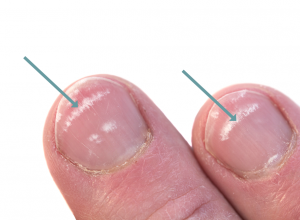
Mees’ Lines
Mees’ lines, a type of leukonychia striata that is also sometimes called Aldrich-Mees’ lines, are longitudinal white lines on a fingernail or toenail that run parallel to the nail’s lunula (the crescent shaped white area that appears at the bed of the nail). They eventually grow out and disappear as the nail lengthens.
Mees’ lines are different from Beau’s lines, which are deep ridges in the nail, and Muehrcke nails, the latter of which affects the vascular nail bed and creates lines that do not grow out when the nail lengthens.
Causes
Mees’ lines typically appear after a person experiences poisoning from arsenic, thallium and other heavy metals. They can also appear in patients who have had chemotherapy or are suffering from renal failure.
Treatment
Mees’ lines will eventually grow out on their own, so there’s no need for treatment of the lines themselves. However, anyone with Mees’ lines should visit a doctor, as they may signify a serious underlying medical condition or exposure to dangerous elements.
History
Mees’ lines are named after Dutch physician R.A. Mees, who described the nail abnormality in 1919. But two other physicians — Englishman E.S. Reynolds and American C.J. Aldrich — first described the condition in 1901 and 1904, respectively.
Notice concerning medical entries:
Articles having medical content shall serve exclusively for the purpose of general information. Such articles are not suitable for any (self-) diagnosis and treatment of individual illnesses and medical indications. In particular, they cannot substitute for the examination, advice, or treatment by a licensed physician or pharmacist. No replies to any individual questions shall be effected through the articles.






